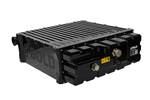Swancor applies EzCiclo recycling resin to Liux EV prototype
Cooperation with Spanish automotive startup has achieved automotive parts comprising EzCiclo RH512 thermoset resin and linen fiber that can be fully separated, adjusted and returned into circularity.
Swancor (Nantou, Taiwain) marks its official entry into the automotive industry with its technology’s successful application in Geko, Spanish startup Liux’s electric vehicle (EV) prototype. The vehicle incorporates EzCiclo RH512, the Swancor thermoset resin containing ≥10% bio-based raw material.
Geko’s automotive fenders, bumpers, doors and tailgate are all made using liner fiber and EzCiclo, meaning they can be fully separated and decomposed through Swancor’s CleaVER liquid at 150˚C for 4 hours. According to Swancor, the decomposition process generates no waste liquid nor exhaust and lower carbon footprint compared with incineration. The recycled liner fiber is remade into yarn after being carded, drawn and twisted; the recycled resin can be used after chemical modification and formula adjustment. During the development process, Swancor conducted numerous testing and adjustments to meet the high standard and strict quality of the automotive industry.
Swancor says it has applied this technology to automotive parts to provide energy efficiency and sustainable solutions for the EV industry. The resulting Liux Geko concept reportedly reduces CO2 footprint throughout its product life by 40% compared to efficient electric cars, and up to 80% compared to a gasoline SUV.
In addition to what was used for this project, Swancor EzCiclo RH512 resin offers another formula containing more than 25% recycled plastics. Both formulas are suitable for vacuum infusion and hand layup process, and can been applied in EV body parts with liner fiber.
Liux Geko will be presented at this year’s JEC World.
Related Content
-
“Structured air” TPS safeguards composite structures
Powered by an 85% air/15% pure polyimide aerogel, Blueshift’s novel material system protects structures during transient thermal events from -200°C to beyond 2400°C for rockets, battery boxes and more.
-
Improving carbon fiber SMC simulation for aerospace parts
Simutence and Engenuity demonstrate a virtual process chain enabling evaluation of process-induced fiber orientations for improved structural simulation and failure load prediction of a composite wing rib.
-
SMC composites progress BinC solar electric vehicles
In an interview with one of Aptera’s co-founders, CW sheds light on the inspiration behind the crowd-funded solar electric vehicle, its body in carbon (BinC) and how composite materials are playing a role in its design.

















